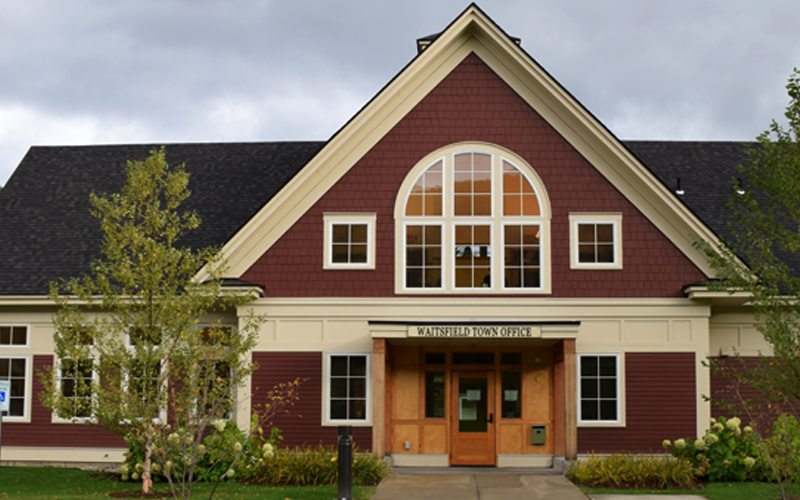In the coming months, the Waitsfield Select Board will need to make decisions on how to proceed with the town-owned General Wait House. At a September 24 meeting, the select board heard a report from the General Wait House advisory committee made up of Bob Burley, Lois De Heer, AnnMarie Harmon (vice-chair), Beth Kendrick and Larissa Ursprung (chair).
Earlier this year, the board hired contractor Brad Cook to draft a report on what work needs to be done on the building. The Cook report indicated some $90,000 in needed repairs and upgrades. The committee members are developing a plan to bring before voters at Town Meeting in March 22.
The plan will include much-needed renovations of the building, review current tenant leases and develop a long-term plan for use and maintenance of the building. The committee identified heating issues, roof replacement, plumbing issues, new windows and other necessary repairs, as well as determining the property management and rental agreements going forward. The schedule for raising rents as outlined in the original purchase agreement for the building has not been followed, the committee reported.
THREE OPTIONS
The progress report that the committee presented to the select board late last month addressed three options. Since that time, the committee formed two groups to prepare its recent update to the board. A final report will be presented to the board in January.
One group addressed Options A1 and A2 together as Repairs/Restoration and Expansion (scenarios in which the town retains ownership); a second group addressed “Alternative Ownership, Management and Use” (scenarios in which the town divests property):
- Phasing (sequencing/priorities).
- Funding mechanisms.
- Long term goals and tasks.
- Ways to maintain connectivity to community.
- Review of past reports and feasibility studies.
- Phasing and timeline for change of ownership.
- Ways to maintain connectivity to community under new ownership.
- Review potential to convert to housing.
Connectivity to the community remains a common denominator across all scenarios, so preliminary brainstorming for community engagement is listed separately.
The committee told the select board that regardless of how the board proceeds in the long-term, there are immediate repairs to the General Wait House necessary for tenant and health and safety concerns. Near-term repairs are compiled from the Cook report and recent tenant disclosures to the tune of $2,050. The town has $65,000 in its current budget to address Wait House issues.
The building was built in 1793, expanded and moved to its current location in the 1830s and purchased by Waitsfield in 1995 before being renovated and a tenanted.
RESEARCH CASE STUDIES
The committee recommended that the town connect with the Vermont Housing and Conservation Board regarding the conservation agreement and easement which covers the Wait House and also recommended that the town research case studies for similar historic restoration projects.
Additionally, committee members recommended developing community engagement tools to gauge public needs and desires and help shape a future feasibility study. Finally partnering with with Preservation Trust Vermont to find funding and grant resources in support of a new feasibility study for the General Wait House property was suggested.
The committee is also suggesting that the town engage with a realtor should the decision be made to sell the property and that the exhibiting Vermont Housing and Conservation Board easement be shared with said realtor as properties encumbered by such easements can decrease the resale value of those properties. Committee members noted that it might be possible to purchase the VHCB easements, but unlikely.
If the town decides to sell the property it would need to complete some repairs so that the building shows better and would need to find a buyer familiar with uses that comply with the VHCB conservation agreement. There may be some grant funding available for some of the necessary maintenance according to the committee’s most recent report, but it is not known if the building would be eligible if the plan is to put the property on the market.
HISTORIC SIGNIFICANCE
Because of the historic significance of the building -- constructed by town founder Benjamin Wait -- a purchaser would have to be found who was interested in continuing to preserve the property for future residents and that buyer would also have to contractually commit to maintaining the building for public use, including maintaining the museum portion and rental spaces. Another possibility which was explored was converting the building to housing, but the committee pointed out that constructing housing would alter the historic integrity of the building.
“Barns are seen as open spaces and when they are chopped up for housing there can be irreversible damage to the historic integrity of the building. A potential buyer would not be able to take advantage of grant money to preserve historic barns if their intention was to convert the barns into housing according to the “Preservation Brief 20: The Preservation of Historic Barns,” U.S. Department of the Interior, National Park Service, Preservation Assistance Division,” the September 24 report notes.
Finally, the committee recommends that public outreach be undertaken to determine community needs and shape the direction of a feasibility student and also that public meetings on the topic be held.







